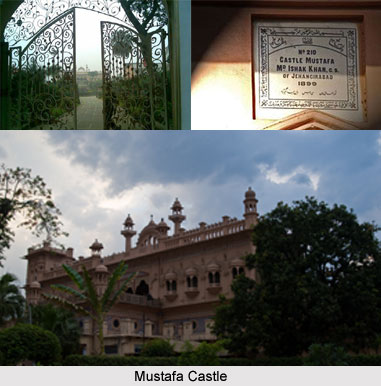 Mustafa Castle is a palatial building located in Meerut of Uttar Pradesh.
Mustafa Castle is a palatial building located in Meerut of Uttar Pradesh.
History of Mustafa Castle
Mustafa Castle was commemoratively built by Nawab Mohammad Ishak Khan to serve as a memorial to Nawab Mustafa Khan Shefta, who was one of the most eminent and accomplished poets and critics of Muslim dynastical era.
Architecture of Mustafa Castle
The construction of Mustafa Castle commenced from 1896 to 1897 and the building was completed in 1900. The first structure, the grandiose gate, was completed in 1899; following which was the Castle itself. The Castle was completely erected by 1900 after a span of 4-5 years of construction. The structure was built by a warm-hearted son, Nawab Mohammad Ishak Khan, in honour of a celebrated, prodigious Persian and Urdu poet, and most importantly a father, Nawab Mustafa Khan Shefta. Nawab M. Ishak Khan designed the building himself, and the imposing project, upon 30 acres of land, was abated and consummated with the help of assistants who possessed considerable experience in building barracks for the armies of the British east India Company. The Nawab amalgamated many styles of architecture in building Mustafa Castle.
Style of Mustafa Castle
Mustafa Castle offers facilities akin to British bungalows and shares prominent features with the buildings of the realm of Rajasthan and Awadh mainly Lucknow. However, the amalgam meant that the edifice of Mustafa Castle was to be peerless amongst others seen in the cities of Delhi, Hyderabad, and Lahore.
Artefacts in Mustafa Castle
Mustafa Castle possesses antique artefacts that belong within the boundaries of Mustafa Castle. It can be attributed to Nawab M. Ishak Khan`s epic tours around the world and his penchant for collecting artefacts. The clay from Mecca was used in the construction procedure and the replacement of an inward gallows with an Islamic mosque.
Nawab Mustafa Khan Shefta and Mustafa Castle
Nawab Mustafa Khan Shefta was a close friend, admirer and, in times of need, a patron of Mirza Ghalib, who was a classical Urdu and Persian poet from India during British colonial rule. A man of letters, he found himself in trouble after the British succeeded in regaining control of Delhi in 1857. Nawab Mustafa Khan`s mother was the daughter of the Commander in Chief of the Mughal army, Ismail Baig Hamadani. Even after the surrender of the Mughal army, Ismail Baig continued his fight for liberalisation against the British and, as a result, retreated to Nepal. Nawab Mustafa Khan was tried for allegedly supporting the uprising which had emanated from Meerut. He was sentenced to seven years of imprisonment and confined in a cell which had been improvised - and later abandoned - for the convicts of the 1857 uprising. This small jail happened to be the centre of the area which is now enclosed by Mustafa Castle. Nawab Mustafa Khan Shefta died in 1869 when Nawab M. Ishak Khan was 9 years of age. Following the aftermath of a vehement emotional surge, the spot of the poet`s imprisonment was purchased by Nawab M. Ishak Khan along with the adjoining area, which comprised nearly 30 acres of land. He then had Mustafa Castle built as his homage to the memory and honour of his father. The cell, in which the poet was imprisoned, has been retained in its unadulterated form so as to conjure a picture of the hardship incurred by Nawab Mustafa Khan Shefta during his imprisonment. That particular chamber, therefore, had been left unaltered by Nawab M. Ishak Khan. The noble family, that had been previously based in Delhi and Jehangirabad, had established Mustafa Castle as its prime premises after the building`s completion in the year 1900, for, mostly, sentimental attributes – a similar building akin to Mustafa Castle, originally belonging to the noble family, exists in the erstwhile family capital of Jehangirabad.
Chambers of Mustafa Castle
Mustafa Castle has several chambers that are named after colours such as `Basanti`, `Gulabi` and so forth. They are used distinctly in summer or winter months with the relevant colour schemes. Some of the originality that remains in the Castle includes furniture that had been imported by Nawab Mohammad Ishak Khan from London, to various showpieces that Mustafa Castle displays with pride.
Collection in Mustafa Castle
Mustafa Castle has the pendulum clocks, ornately designed lamps, antique chandeliers, carved wooden cabinets, chests, dressing tables, cupboards and drawers, antique lampshades, candle-stands, mirrors and historic portraits, which are amongst some of the rare artefacts that have been preserved from century-old lifetime to the national and international tourists.




